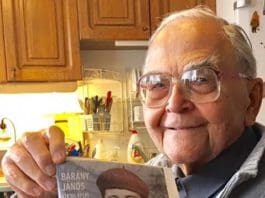The day Soviet tanks crushed democracy, and the bitter battle over its legacy
By Stefan J. Bos, Chief International Correspondent BosNewsLife in Budapest. A co-production with Australian Broadcasting Corporation (ABC).
 BUDAPEST, HUNGARY (BosNewsLife/ABC)– Millions in Europe have been remembering Soviet forces storming the streets of Budapest, killing thousands and crushing Hungary’s fight for freedom in 1956. But as the country lurches to the political right under Prime Minister Viktor Orbán, the revolution is being recast as a patriotic fight against foreign domination … with the EU villainised as the new oppressor.
BUDAPEST, HUNGARY (BosNewsLife/ABC)– Millions in Europe have been remembering Soviet forces storming the streets of Budapest, killing thousands and crushing Hungary’s fight for freedom in 1956. But as the country lurches to the political right under Prime Minister Viktor Orbán, the revolution is being recast as a patriotic fight against foreign domination … with the EU villainised as the new oppressor.
Commemorating the Freedom Fight, Orbán said that, “Freedom-loving peoples of Europe must save Brussels from Sovietisation”.
Speaking to a crowd of thousands on the National Day of Remembrance, that marks the beginning of the uprising, he condemned the European Union’s humanitarian migration policies, portraying them as a kind of tyranny.
Bullet holes of Hungary’s 1956 battles for freedom seen in Budapest buildings.
“We, Hungarians, want to remain a European nation, rather than become an ethnic minority in Europe,” he said.
“It is only our national independence that can save us from being devoured by an empire.
ORBAN’S TOUCHSTONE
The 1956 revolution has become Orbán ‘s touchstone for Hungary’s anxiety about sovereignty.
Now a leading figure of that uprising, Imre Mécs , has called Prime Minister Orbán‘s leadership “a tragedy”. “He is a tragedy, not only for Hungary, but for all of Europe,” Mécs, 83, told the ABC and BosNewsLife. “A normal person would defend European values.”

The 1956 revolution began on 23 October with a few hundred university students protesting against Soviet repression, and snowballed to 200,000 protesters on the streets, with people rising up around the country.
They demanded an end to one-party rule, and appealed for press freedom and democracy.
But 19 days later — 60 years ago today — 100,000 Russian soldiers and thousands of tanks rolled into town and in a bloody fusillade devastated democratic hopes for another 35 years.
Remembering the tragedy Hungarian Prime Minister Viktor Orbán appears on stage speaking during the remembrance ceremony of the hungarian revolution
MANY VICTIMS
Survivors still recall the many victims in their nightmares.
Bye, bye comrades an iconic poster reads referring to the end of occupying Soviet forces in Hungary in 1990

“I witnessed how people toppled the statue of Soviet leader Stalin in Budapest,” says Imre Czigány, 70, remembering the crowd chanting: “Russians out, Russians go home.”
“I was only 10, but I remember everything. The shooting and the fighting went on where I was living. I saw the tanks rolling, I saw the fights,” he remembers, close to tears.
“I saw the dead bodies lying on the ground. I will never forget that. Never, never. And I don’t want to.”
It was, he says, “where Hungarians really showed where they are: on the side of freedom”.
His voice trembles as he admits, “I am still emotional about it. This was a turning point in my life”.
PROTESTS CONTINUE
Czigány was among the tens of thousands who rallied to hear Prime Minister Orbán in front of Budapest’s Neo-Gothic-style parliament building on Remembrance Day.
Demonstrators blocked by police in hungary

The Government spent millions of dollars on the event, with billboards lining the streets showing young 1956 street fighters carrying arms, and specially commissioned songs.
But rather than celebrating hard-won democratic freedoms, the Prime Minister, who has clamped down on the free press and become increasingly authoritarian, has built a narrative around the rebel fighters, striking a patriotic chord.
Ágnes Szent-Ivány, 63, was there supporting Orbán, even though she and her family fought for freedom during the Soviet regime.
“Hungarians voted three times to have Mr. Orban as prime minister, the last two times with a two-thirds majority,” she says, explaining he stands for Hungarian independence.
Her family was persecuted by the Soviets for being Catholic intellectuals. She says the regime divided the country.
SOVIET SYSTEM
“There were those who were against the Soviet system and those who collaborated with the Soviets to gain many benefits,” she explains.
Rousing the crowd, Orbán was drowned out by thousands of protesters, blowing whistles and shouting, “dictator!”
Clearly irritated and shouting, Orbán accused the protesters of being Soviet-style communists. Without irony he aligned himself with the cause of freedom.
“There was a revolution against the communist world,” he yelled above the din.
Szent-Ivány agreed, calling the protesters “Godless atheists”.

The protesters hold different views.
“Viktor Orbán’s policies are exactly the kind Hungarians rebelled against in 1956,” says Opposition Leader Péter Juhász, Vice President of the Together party which organised the protests.
He questions Orbán’s democratic credentials.
“Hungarians stood up to Soviet domination, while Orban has committed Hungary to Russia for decades,” says Juhasz referring to a recent nuclear power deal.
Former freedom fighter, Mécs, rejects Orbán’s rewriting of history.
“Communists died for freedom too,” he says.
He should know. The famed Liberal elder statesman and author spent six years on death row for his role in the 1956 Revolution, before being released in 1963.
With teary eyes he holds a picture of a young fallen comrade.
“He was a communist but fought for freedom. I said farewell to him just before his execution,” he says.
STAYING BEHIND
Mécs stayed in Hungary, becoming a liberal politician when democracy finally arrived.
But in the purge of dissidents that followed the 1956 crackdown, 200,000 Hungarians fled the country. The young Imre Czigány was one.
His father had been facing the death penalty for subversion when freedom fighters stormed the prison in 1956 and freed him.
In the vicious aftermath of the uprising, the family fled to Germany.
“We had to leave at the last second, otherwise they would have taken my father back to prison,” Czigány says.
The flood of refugees were embraced in Western nations.
It’s drawn comparisons with the hostile razor-wire fence that greets the current influx of refugees streaming out of the Middle East, and rejection of EU refugee quotas by the staunchly anti-migrant Orbán.
‘MORE INVADERS’
He’s portrayed them as yet more invaders threatening Hungary, invoking the shadow of a centuries old battle, when Hungary was overrun by Muslim invaders from the Ottoman Empire.

It’s etched deeply into Hungarian consciousness, much as Gallipoli is in Australia.
Friends and foes agree that he skilfully uses fear of foreign invaders to increase his popularity, and distract attention from economic difficulties and other social ills in this former Soviet state.
It leaves his people sharply divided over liberal European values.
Mr Czigány, who lived in Germany and Belgium before he eventually returned to Hungary, is, like his country, “wandering between two worlds”.
He and others regret that after finally being freed from Soviet domination in 1990, Hungary’s society is more divided than ever, posing a threat to the already shaky European Union.
UNITED IN SUFFERING
Yet divided as they are over politics, Hungarians of all ages appear united in suffering. The 1956 Revolution also impacted younger generations. The 49-year-old journalist Tamás S. Kiss pauses in front of the building in Budapest where his father was interrogated by Hungarian police.
“My father was a freedom fighter. When he was just 19 years old he and his student friends raided a police station to gather weapons to fight the Soviets,” he told BosNewsLife.
“After the Revolution failed he had to flee because he would have been executed. He lived in South Africa where I was born. Years later, my mom got homesick and he agreed to return to Hungary with his family.”
István Kiss wasn’t warmly welcomed. “My father was interrogated in Budapest soon after he arrived in 1983 because of his past. Every second month he had to go to report, despite having received an “Amnesty”.”

Tamás S. Kiss suffered too. “I wasn’t allowed to go to the vet university because of my father’s role in the 1956 Revolution and despite securing a promising job at the Central Veterinarian Institute.”
A few years ago, his father passed away. “Sometimes I wonder what he would have thought about Hungary today. He always warned us: ‘the old habits never die’.”
Former freedom fighter Mécs is calling for change. “Just as Moses in the Bible had to lead the people of Israel from Egypt to the Promised Land, so Hungary has to deal with its past. I think we need a real new generation of leadership to bring Hungary true freedom,” he says.
(BosNewsLife’s NEWS WATCH is a regular feature following general news developments especially in but not limited to (former) Communist countries and other (former) autocratic states impacting the Church and compassionate professionals worldwide. BosNewsLife is based in Budapest, Hungary. )



